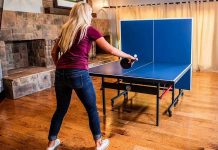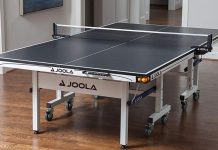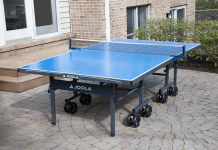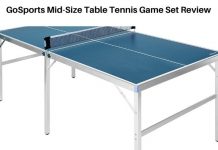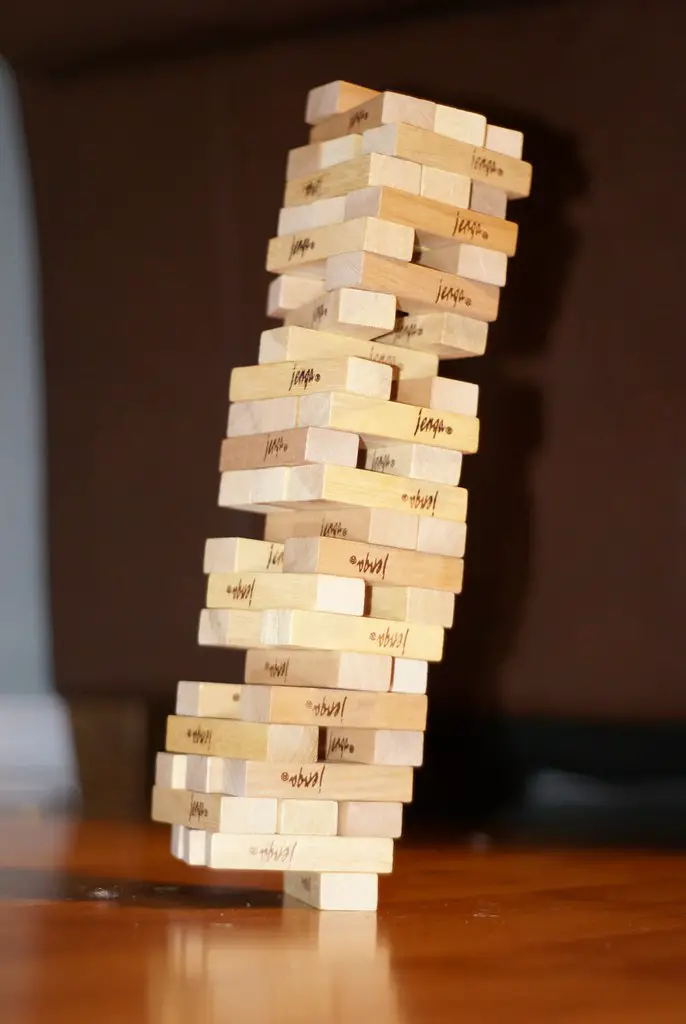Most people remember the good ol’ days of childhood. Sitting on the floor of the daycare trying to build the biggest structure with wooden blocks. Meanwhile, the other kids try to knock down all your hard work. The game of Jenga is kind of like that– only you’re the one trying to make the tower fall down on those other kids.
Take turns pushing and pulling blocks from the tower as you build it higher. The goal of the game is to keep the tower from falling over on your turn. But if it crashes on the next player then you win. There are also some neat variations such as Giant Jenga, and Movie themed blocks.
Table of Contents
Is There a Strategy to Jenga?
Yes, there is in fact a strategy to winning the game of Jenga. There isn’t one specific strategy to winning, but more like a collection of best practices. Like many of the games we cover, it’s a mix of luck and planning. There are plenty of techniques to put into place but you should think of the game in three specific key areas.
What to Focus on:
- Tower Structure
- Manual Dexterity
- Focus
Jenga Tower Structure
1. A House Divided Against Itself
Not only do you have to consider that all of the blocks are slightly different sizes, but you also have to consider how to move the pieces just so. The main goal is maintaining structure stability on your turn in the hopes that the next player might not be so lucky.
The top two rows are off-limits. However, the rest of the tower is your oyster. Depending on what the last player left you will determine your plan of attack. Follow these general rules in order when making your move.
2. Check Stability
Before anything else, gently tap or bump the tower to see how well the structure is holding up. You can skip this at the beginning of the game’s first turn.
Bumping the tower will help you see what’s the most vulnerable to fall and which pieces are loose enough for you to push easily. If it gives you resistance, leave it alone for now.
Related: Battleship Placement Strategies
3. Technique is Everything
A common mistake players make is trying to pull blocks from the tower. Pulling blocks can cause rapid destabilization. If you push on a block you can take your time slowly removing it from the stack.
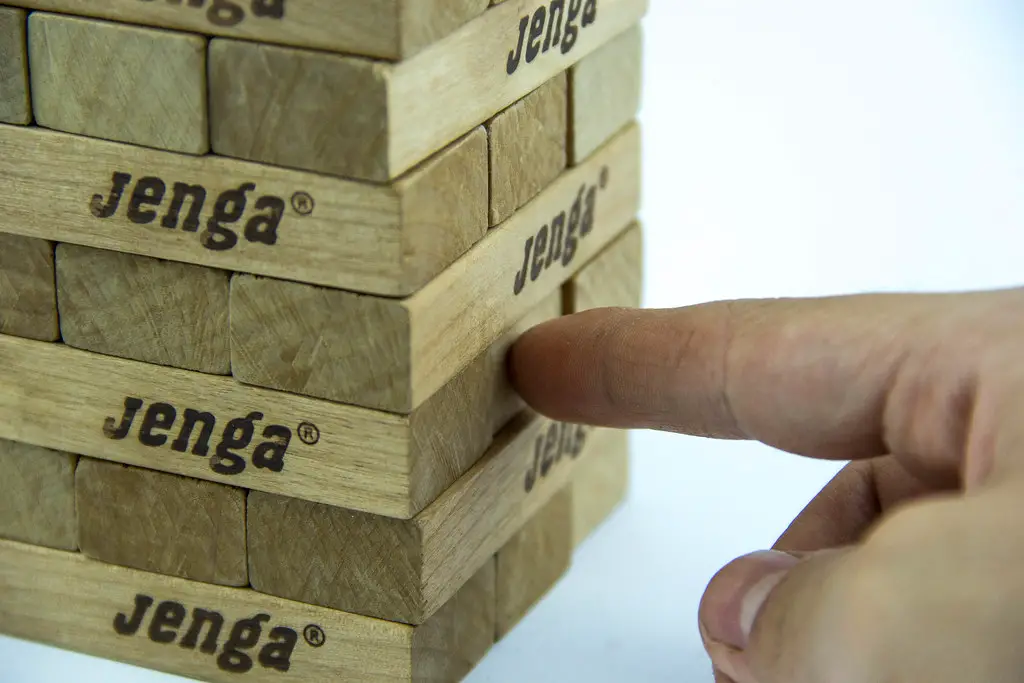
As you push on the block, focus on how the overall tower feels. If it starts to seem wobbly, change which piece you’ve settled on. Your opponents might get angry with your indecision, but if you want to win, you have to be patient.
4. Aim High
After you’re sure the tower is in good shape. You should take the pieces that are the highest on the tower as possible. By doing this you are minimizing the risk it will fall on your turn. It’s also helping maintain a strong base.
5. Great and Small
As you scan over the pieces, look for the blocks that appear thinner than the others. Due to the way the game is made, all the pieces of wood are cut differently causing some of them to be thicker or thinner. Do your best to push the thin pieces first and leave the thicker ones until the end.
6. Front and Center
Next focus on taking blocks from the center rather than the sides. The center pieces make the most sense to take because the left and right blocks help keep the building stable. Keep taking center pieces as much as you can. It forces your opponents to take the wonky side pieces.
Or if you want to start messing up their game, alternate taking side pieces every other row. Eventually, this will cause more instability, and hopefully, that luck runs out on your rival’s turn.
7. Balancing Act
Once all the center blocks are taken, start shifting side pieces to the center. The idea is to push the left or right towards the center and then push the block not in the center out of the tower.
Take your time. It will be challenging near the end of the game to keep the tower centered. If it starts to sway, take a moment to let it settle before moving the piece again.
8. Keep it Pretty
There’s just something about an even, balanced arrangement that’s pleasing to the human eye. It’s also the best strategy to keep the tower stable. As you move pieces from the lower part of the stack to the top, keep the tower as symmetrical as you can. If you take it from the left, put it on the top right and vice versa.
As you build it taller, keep watching to see if the tower is leaning in any particular direction. Remember to put the piece on the opposite side to keep it from leaning further.
Or if you’re feeling lucky, keep building up that unbalanced tower. You might just be able to sabotage the next player this way.
9. Don’t Be Competitive
Even Leslie Scott herself says to avoid trying to build the tallest tower. Focus on keeping the tower stable rather than as tall as possible. Once the base is weakened, the more the tower has to hold up. Eventually, you’ll get to a point that the base can’t hold such a tall structure.
If you’ve been paying attention to the previous rules, and maintaining structure, then you shouldn’t have this problem. Don’t be in a rush. Some more eager players may get impatient and make a rash decisions. Then victory will be in your hands.
Manual Dexterity in Jenga
10. Fancy Fingers (And elbows)
Next, we must consider how we move our fingers and hands. (And sometimes forearms!) A crucial part of this game is a steady hand and an eye with attention to detail. The more you can practice your general dexterity, the game of Jenga will reward you with victory.
11. In Tune
Keep your fingers still and light as you move pieces. Move with intent, but be aware of keeping your body controlled. Keep a sharp eye on the structure as you move any pieces. And be ready to slow down or change direction as needed. Sometimes when you first try to push a piece out, it might not go the way you thought it would.
Consider practicing other hand skills such as throwing, catching, and squeezing. You can even do hand and finger stretches to increase your manual dexterity if you find yourself having trouble.
12. Switch it Up
If you find yourself struggling to claim a certain piece on the tower, try using your non-dominant hand. Look at the way the piece sits. Try looking at it from a different angle. Staying rigid in your approach will cause you to lose.
Related: 10 Tips to Win at Uno
13. Arms and Elbows, Oh My!
According to the rules, it says only one hand at a time. However many players enlist the use of their forearm, elbows, or wrists as a way to stabilize the tower when taking a piece. This can be especially useful towards the end of the game when it’s more wobbly.
Slowly push on the piece and keep your forearm against the edge. As the piece pushes out, you can keep the tower steady and straighten it out.
14. Use Specific Methods
According to gamesver.com, they have outlined a couple of methods you could try when putting those fingers to work.
- Door method
- When removing a tight block, you swing the block open, and then close it again to loosen it. Do this until it’s close to the edge for removal.
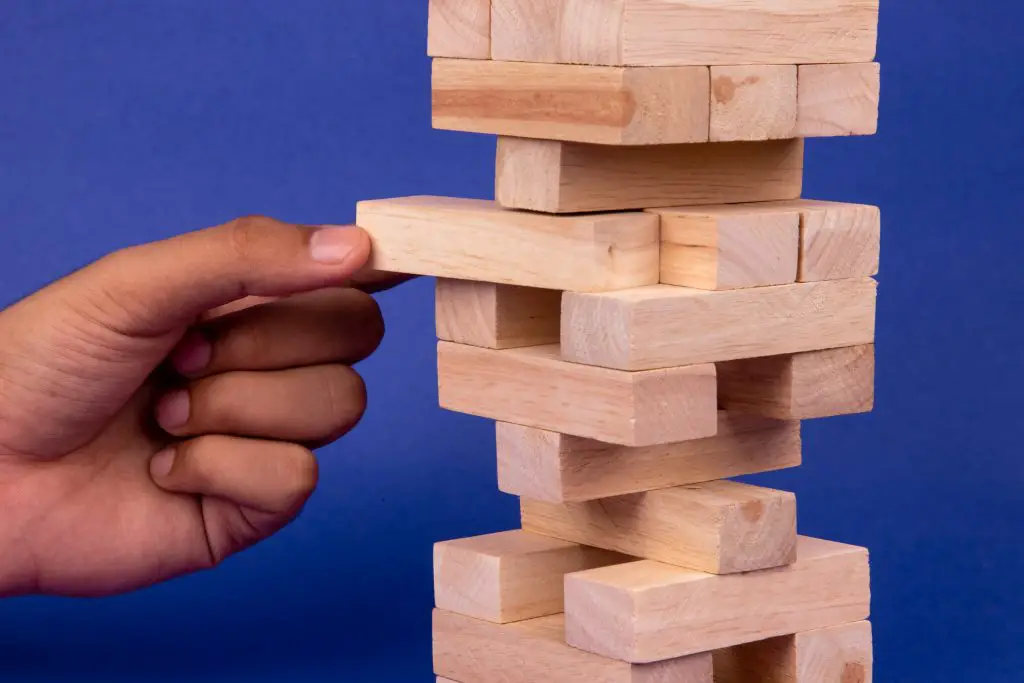
- Index finger and nail support method
- This can be used in conjunction with the door method. Hold the tighter piece with your thumb and ring finger. Your index finger and nail will support the piece as it leaves.
Use Focus in the Game of Jenga
15. It’s Very Zen
The last piece to your Jenga strategy is to work on your focus and patience. It’s natural to fall into a brisk rhythm when playing a game. Your competitive spirit might start to come out as your opponents start pulling pieces.
If you can maintain your cool, and calculate your next steps while being flexible, then you’ll have no trouble winning.
16. Don’t Rush
The point of Jenga is to think about the structure as a whole. Use the steps outlined in the Structure strategy to calculate your moves. But bear in mind that some pieces have shifted since the game first started. Go back to those pieces as needed. If your rivals get impatient, remind them it’s not a race.
If other players start to take an excessive amount of time, then think about implementing time limits. In fact, you could create a fun variation of Jenga this way. Throw the basic strategy of patience out the window and pull those pieces as fast as you can. This will result in a lot of wreckage, but at least you’re having fun.
17. Take it One Piece at a Time
You may be tempted to think several moves ahead like in Battleship or Checkers, but this is a trap. Unfortunately, your moves are heavily dependent on how the tower is move to move. What was a viable move last turn, may turn into a bad decision the next. On the same note, when you think about the piece that is safest for you, think about the way that piece could mess up the next player.
Try moving the piece in a way that makes less sense. If you do this enough times in a calculating way, eventually the tower will tip in your favor.
18. Keep Your Eye on the Prize
If you really want to win the game, you’ll need to eliminate all distractions. Keep the TV, radio, and anything else off to the side. That includes your phone. Take deep breaths to help you re-center your focus. Try counting to three before making your move. If you’re the kind of person who struggles to focus in general, you might try meditating. Even mantras can work to help you keep zeroed in on the task at hand.
19. Sabotage Your Opponents
This goes hand in hand with the last tip. You need to stay focused, but that doesn’t mean you can’t throw off the other players. Sing, tap your fingers on the table or even start asking them questions. They might get so distracted they knock down the tower or even forget which piece they really wanted to pull.
Note that you want to be distracting in a fun way, but not a jerk. No one is going to want to play with someone like that.
Related: The Complete Clue Strategy Guide
20. Form a New Strategy
All of these tips will be more relevant in some games. Every time you stack the tower it will be a completely different scenario because of how the different pieces are cut. Or you might be playing with a different set of people with various ways of playing. Although many players will tell you that you shouldn’t stick to a strategy, using the tips in this list will serve you well.
What’s the Best Way to Win Jenga?
The best way to win Jenga is to be patient and calculating. As you’ll notice that many of the tips talked about taking your time. Most games reward the player for being aggressive or quick-witted. Even though you should keep your wits about you, the game of Jenga rewards players who can pause to reflect. Similar to a game of chess every piece is different and will come from the stack in a unique way.
Stay flexible in your efforts to remove pieces. If someone takes the piece you were aiming for, don’t lose hope– pivot. Build the tower up beautifully rather than as high as possible. Keep your fingers light. Push pieces gently. Don’t be afraid to change your mind about a piece after you’ve tapped it. Your gut won’t lead you wrong.
Keep these tips and you’ll be well on your way to show those other kids who’s the King of Jenga next Game Night.

Veronica is a Green Bay-based freelance writer and editor with extensive experience with board games. When not busy scribbling her thoughts, you might find her in her garden, hiking out in the woods, or exploring new food joints.
Veronica is a die-hard board game and chess hobbyist by night. She likes to try out new games and is always on the lookout to recruit new players for her game night (so beware!). When not playing board games or throwing darts, she is usually busy painting miniatures (or doing other nerdy stuff).
She is the CEO & Content Writer of Indoor Games Zone. She shares her expertise from years of playing chess, board games, and darts.

![Stiga XTR Pro Review | 1,559+ Global Ratings (In-Depth Guide) [year] Stiga XTR Pro Review](https://indoorgameszone.com/wp-content/uploads/2021/08/Stiga-XTR-Pro-Review-218x150.jpg)
